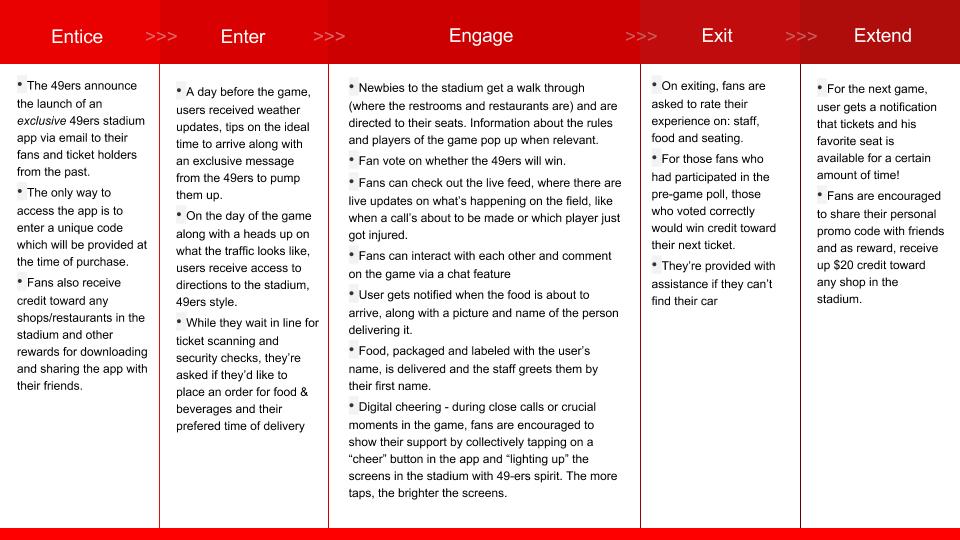Author Archives: Michie Cao
49ers Goals and Parameters – Aastha, Michie, Leroy, Sam C
Fans visit the stadium to cheer on their favorite teams alongside other fans. But besides a live viewing experience, what additional incentive does this experience offer?
In our vision of the modern in-stadium experience, we hope to offer an experience that is even more engaging and exciting than the current one. The 49ers digital app will encourage team spirit by providing a platform for fans to interact with each other and bridge information gaps that happen as a live game unfolds with instant replays, footage and commentary. Fans – new and old – will feel more involved in the game, as though they’re part of the team. Though filled with endless cheering, clapping, heckling and discussing, the environment will remain just as comfortable as the one in your own home.
We plan to achieve this by:
- Building expertise for newcomers and first timers by introducing them to the game and customs of football
- Building an exclusive, personal relationship between the fans and the staff at the Levi’s Stadium. For example, food servers will know who they are delivering orders to by name and face and vice versa.
- Encouraging face-to-face and digital interaction between the fans, especially during celebrations and losses. This could be via a live chat channel or app-facilitated activities.
- Offering an enhanced, personalized experience, based on the user’s preferences, location and other personal data. For instance, the app can show only the stats of their favorite players or highlight only their favorite food options when shown the food menu.
Parameters
- The app should be an extension of the live football experience and not a distraction.
- Without football commentators or stats constantly available to supplement the live game (as is the case on TV), live viewers don’t always get the full picture of the game right away.
- How will the app be funded? If funded by the team’s commercial partners, there might need to be opportunities for advertising included.
- Technology: built-in ticket scanners, LCD screens and scoreboards, iBeacons, WiFi and cameras surrounding the stadium
Filed under 49ers-G&P, Uncategorized
49ers Diverge Research – Aastha, Michie, Sam C, Leroy
Our market and user research and creation myth is available here: Week4_PublicSpaces
Filed under 49ers Diverge (research)
Visualizing Subway Train States
Last semester, I worked with Sunnie Sang on an energy tracking app for household appliances called Zooly. We personified home appliances as living, breathing pets in a menagerie that can be healthy, sick, a vampire, or a ghost.
MTA subway trains go through many states as well and what if we could similarly visualize them for users in a more delightful way? Not only does this lend more of a fun and emotional quality to what is often seen as an unpleasant and cold experience, but it can also provide glance-able information in the MTA mobile app or subway interactive screens to on-the-go users.
Here’s the link to the presentation: https://www.dropbox.com/s/8hnz1nd2a67c0y9/Zooly_MTA.pdf?dl=0
Filed under Projects, Quick Indie Project, Uncategorized
Michie on “Third Places”
I come from the so-called suburbia Ray Oldenburg describes in “Our Vanishing ‘Third Places’”. My childhood home has a property gate which defines the threshold between public and private property, a garage to house the cars which transport us to our nearest grocery stores and/or meetings with friends, and a fair amount of entertainment devices that keep us properly entertained in-house. Indeed, as Ray suggests, there was rarely a need for family to venture beyond that on the day-to-day.
For this reason, Oldenburg’s idea of “third places”, or informal gathering places, is intriguing to me. It explains why I’d always found an interest living in densely populated cities like New York and San Francisco. Where public gathering spaces are deeply integrated into the urban fabric of a city, there are endless opportunities for social interaction – i.e. public events, shops or even just on the street. Though this comes at the cost of personal privacy or individual autonomy, there’s no denying the fact that the living experience is more lively and the community more unified. Particularly for the young and the old, who in suburbia generally do not have the means or capacity to travel the long distances between the home and the nearest community center, this is crucial. My 81-year-old grandmother, who cannot drive and lives in a quiet, tree-lined residential neighborhood, looks forward to visits or meals out with the family, since they provide the sole opportunity of engaging with the community beyond her home.
As an answer to our lost physical “third places,” we have since created digital equivalents. Examples of this are social network platforms and online forums like Facebook or Reddit, which provide the ability to congregate, discuss and connect with others; and crowd-based service applications like Lyft and AirBnB that pride themselves on being able to encourage greater community engagement. With the exception of daily and spontaneous face-to-face interactions, digital “third places” arguably give us all that we could ever want or need on a scale that we could otherwise never recreate in the physical world.
I’m not sure what the next trend will be and whether we’ll eventually reach a happy medium between both physical and digital “third places”, but I’m definitely interested in seeing how that will play out in the future.
Filed under Readings, Third Places, Uncategorized

